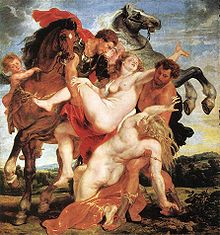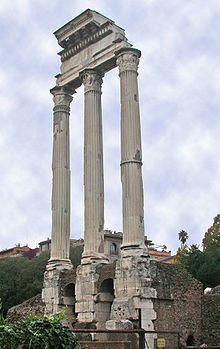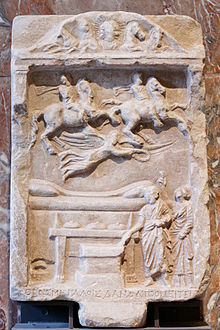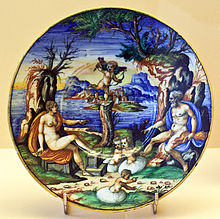- Castor and Pollux
-
For other uses, see Castor and Pollux (disambiguation).
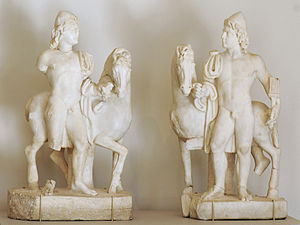 Pair of Roman statuettes (3rd century AD) depicting the Dioscuri as horsemen, with their characteristic skullcaps (Metropolitan Museum of Art)
Pair of Roman statuettes (3rd century AD) depicting the Dioscuri as horsemen, with their characteristic skullcaps (Metropolitan Museum of Art)
In Greek and Roman mythology, Castor (
 /ˈkæstər/; Latin: Castōr; Greek: Κάστωρ, Kastōr, "beaver") and Pollux (
/ˈkæstər/; Latin: Castōr; Greek: Κάστωρ, Kastōr, "beaver") and Pollux ( /ˈpɒləks/; Latin: Pollūx) or Polydeuces (
/ˈpɒləks/; Latin: Pollūx) or Polydeuces ( /ˌpɒlɨˈdjuːsiːz/; Greek: Πολυδεύκης, Poludeukēs, "much sweet wine"[1]) were twin brothers, together known as the Dioscuri (
/ˌpɒlɨˈdjuːsiːz/; Greek: Πολυδεύκης, Poludeukēs, "much sweet wine"[1]) were twin brothers, together known as the Dioscuri ( /daɪˈɒskjəraɪ/; Latin: Dioscūrī; Greek: Διόσκουροι, Dioskouroi, "sons of Zeus"). Their mother was Leda, but Castor was the mortal son of Tyndareus, king of Sparta, and Pollux the divine son of Zeus, who visited Leda in the guise of a swan. Though accounts of their birth are varied, they are sometimes said to have been born from an egg, along with their twin sisters Helen of Troy and Clytemnestra.
/daɪˈɒskjəraɪ/; Latin: Dioscūrī; Greek: Διόσκουροι, Dioskouroi, "sons of Zeus"). Their mother was Leda, but Castor was the mortal son of Tyndareus, king of Sparta, and Pollux the divine son of Zeus, who visited Leda in the guise of a swan. Though accounts of their birth are varied, they are sometimes said to have been born from an egg, along with their twin sisters Helen of Troy and Clytemnestra.In Latin the twins are also known as the Gemini (
 /ˈdʒɛmɨnaɪ/; "twins") or Castores (
/ˈdʒɛmɨnaɪ/; "twins") or Castores ( /ˈkæstəriːz/). When Castor was killed, Pollux asked Zeus to let him share his own immortality with his twin to keep them together, and they were transformed into the constellation Gemini. The pair were regarded as the patrons of sailors, to whom they appeared as St. Elmo's fire, and were also associated with horsemanship.
/ˈkæstəriːz/). When Castor was killed, Pollux asked Zeus to let him share his own immortality with his twin to keep them together, and they were transformed into the constellation Gemini. The pair were regarded as the patrons of sailors, to whom they appeared as St. Elmo's fire, and were also associated with horsemanship.They are sometimes called the Tyndaridae or Tyndarids (
 /tɪnˈdɛrɨdiː/ or /ˈtɪndərɪdz/; Τυνδαρίδαι, Tundaridai), later seen as a reference to their father and stepfather Tyndareus.
/tɪnˈdɛrɨdiː/ or /ˈtɪndərɪdz/; Τυνδαρίδαι, Tundaridai), later seen as a reference to their father and stepfather Tyndareus.Contents
Birth and functions
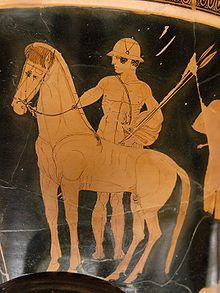 Castor depicted on a calyx krater of ca. 460-450 BC, holding a horse's reins and spears and wearing a pilos-style helmet
Castor depicted on a calyx krater of ca. 460-450 BC, holding a horse's reins and spears and wearing a pilos-style helmet
The best-known story of the twins' birth is that Zeus disguised himself as a swan and raped Leda. Thus Leda's children are frequently said to have hatched from two eggs that she then produced. The Dioscuri can be recognized in vase-paintings by the skull-cap they wear, the pilos, which was explained in antiquity as the remnants of the egg from which they hatched.[2] Tyndareus, Leda's mortal husband, is then father or foster-father to the children.[3] Whether the children are thus mortal and which half-immortal is not consistent among accounts, nor is whether the twins hatched together from one egg. In some accounts, only Polydeuces was fathered by Zeus, while Leda and her husband Tyndareus conceived Castor. This explains why they were granted an alternate immortality. It is a common belief that one would live among the gods, while the other was among the dead.[citation needed] The figure of Tyndareus may have entered their tradition to explain their archaic name Tindaridai in Spartan inscriptions or in literature Tyndaridai,[4] in turn occasioning incompatible accounts of their parentage.
Castor and Polydeuces are sometimes both mortal, sometimes both divine. One consistent point is that if only one of them is immortal, it is Polydeuces. In Homer's Iliad, Helen looks down from the walls of Troy and wonders why she does not see her brothers among the Achaeans. The narrator remarks that they are both already dead and buried back in their homeland of Lacedaemon, thus suggesting that at least in some early traditions, both were mortal. Their death and shared immortality offered by Zeus was material of the lost Cypria in the Epic cycle.
The Dioscuri were regarded as helpers of mankind and held to be patrons of travellers and of sailors in particular, who invoked them to seek favourable winds.[5] Their role as horsemen and boxers also led to them being regarded as the patrons of athletes and athletic contests.[6] They characteristically intervened at the moment of crisis, aiding those who honoured or trusted them.[7]
Classical sources
Ancient Greek authors tell a number of versions of the story of Castor and Pollux. Homer portrays them initially as ordinary mortals, treating them as dead in the Iliad, but in the Odyssey they are treated as alive even though "the corn-bearing earth holds them." The author describes them as "having honour equal to gods," living on alternate days due to the intervention of Zeus. In both the Odyssey and in Hesiod, they are described as the sons of Tyndareus and Leda. In Pindar, Pollux is the son of Zeus while Castor is the son of the mortal Tyndareus. The theme of ambiguous parentage is not unique to Castor and Pollux; similar characterisations appear in the stories of Hercules and Theseus.[8] The Dioscuri are also invoked in Alcaeus' Fragment 34a, though whether this poem antedates the Homeric Hymn to the twins is unknown.[9] They make an appearance together in two plays by Euripides, Helen and Elektra.
Cicero tells the story of how Simonides of Ceos was rebuked by Scopas, his patron, for devoting too much space to praising Castor and Pollux in an ode celebrating Scopas' victory in a chariot race. Shortly afterwards, Simonides was told that two young men wished to speak to him; after he had left the banqueting room, the roof fell in and crushed Scopas and his guests.[7]
Adventures
Both Dioscuri were excellent horsemen and hunters who participated in the hunting of the Calydonian Boar and later joined the crew of Jason's ship, the Argo.
As Argonauts
During the expedition of the Argonauts, Pollux took part in a boxing contest and defeated King Amycus of the Bebryces, a savage mythical people in Bithynia. After returning from the voyage, the Dioskouroi helped Jason and Peleus to destroy the city of Iolcus in revenge for the treachery of its king Pelias.
Rescuing Helen
When their sister Helen was abducted by the legendary Greek king Theseus, they invaded his kingdom of Attica to rescue her, abducting Theseus' mother Aethra in revenge and carrying her off to Sparta while setting a rival, Menestheus, on the throne of Athens. Aethra was forced to become Helen's slave but was eventually returned to her home by her grandsons Demophon and Acamas following the fall of Troy.
The Leucippides, Lynceus and death
Castor and Pollux aspired to marry the Leucippides ("daughters of the white horse"), Phoebe and Hilaeira, whose father was a brother of Leucippus ("white horse").[10] Although both women were already betrothed to counterpart twin brothers of Thebes, Lynceus and Idas, sons of Aphareus, Castor and Pollux carried them off to Sparta, where Phoebe bore Mnesileos to Pollux and Hilaeira bore Anogon to Castor. This began a feud among the four cousins.
The cousins carried out a cattle-raid in Arcadia together but fell out over the division of the meat. After stealing the herd, but before dividing it, the cousins butchered, quartered, and roasted a calf.[11] As they prepared to eat, the gigantic Idas suggested that the herd be divided into two parts instead of four, based on which pair of cousins finished their meal first.[11] Castor and Pollux agreed.[11] Idas quickly ate both his portion and Lynceus' portion.[11] Castor and Pollux had been duped. They allowed their cousins to take the entire herd, but vowed to someday take revenge.[11]
Some time later, Idas and Lynceus visited their uncle's home in Sparta.[11] The uncle was on his way to Crete, so he left Helen in charge of entertaining the guests, which included both sets of cousins, as well as Paris, prince of Troy.[11] Castor and Pollux recognized the opportunity to extract revenge, made an excuse that justified leaving the feast, and set out to steal their cousins' herd.[11] Idas and Lynceus eventually set out for home, leaving Helen alone with Paris, who then kidnapped Helen.[11] Thus, the four cousins helped set into motion the events that gave rise to the Trojan War.
Meanwhile, Castor and Pollux had reached their destination. Castor climbed a tree to keep a watch as Pollux began to free the cattle. Far away, Idas and Lynceus approached. Lynceus, named for the lynx because he could see in the dark, spied Castor hiding in the tree.[11] Idas and Lynceus immediately understood what was happening. Idas, furious, ambushed Castor, fatally wounding him with a blow from his spear—but not before Castor called out to warn Pollux.[11] In the ensuing brawl, Pollux killed Lynceus. As Idas was about to kill Pollux, Zeus, who had been watching from Mt. Olympus, hurled a thunderbolt, killing Idas and saving his son.[11]
Returning to the dying Castor, Pollux was given the choice by Zeus of spending all his time on Mount Olympus or giving half his immortality to his mortal brother. He opted for the latter (so giving half his immortality to Castor), enabling the twins to alternate between Olympus and Hades.[12][13] The brothers became the two brightest stars in the constellation Gemini ("the twins"): Castor (Alpha Geminorum) and Pollux (Beta Geminorum). As emblems of immortality and death, the Dioscuri, like Heracles, were said to have been initiated into the Eleusinian mysteries.[14]
Iconography
Castor and Pollux are consistently associated with horses in art and literature. They are widely depicted as helmeted horsemen carrying spears.[12] The Pseudo-Oppian manuscript depicts the brothers hunting, both on horseback and on foot.[15]
On votive reliefs they are depicted with a variety of symbols representing the concept of twinhood, such as the dokana (δόκανα - two upright piece of wood connected by two cross-beams), a pair of amphorae, a pair of shields, or a pair of snakes. They are also often shown wearing felt caps, above which stars may be depicted. They are depicted on metopes from Delphi showing them on the voyage of the Argo (Ἀργώ) and rustling cattle with Idas. Greek vases regularly show them in the rape of the Leucippides, as Argonauts, in religious ceremonies and at the delivery to Leda of the egg containing Helen.[8] They can be recognized in some vase-paintings by the skull-cap they wear, the pilos (πῖλος), which was already explained in antiquity as the remnants of the egg from which they hatched.[16]
Shrines and rites
The Dioskouroi were worshipped by the Greeks and Romans alike; there were temples to the twins in Athens and Rome as well as shrines in many other locations in the ancient world.[17]
The Dioscuri and their sisters having grown up in Sparta, in the royal household of Tyndareus, they were particularly important to the Spartans, who associated them with the Spartan tradition of dual kingship and appreciated that two princes of their ruling house were elevated to immortality. Their connection there was very ancient: a uniquely Spartan aniconic representation of the Tyndaridai was as two upright posts joined by a cross-bar;[18] as the protectors of the Spartan army the "beam figure" or dókana was carried in front of the army on campaign.[19] Sparta's unique dual kingship reflects the divine influence of the Dioscuri. When the Spartan army marched to war, one king remained behind at home, accompanied by one of the Twins. "In this way the real political order is secured in the realm of the Gods" (Burkert 1985:212).
Their herōon or grave-shrine was on a mountain top at Therapne across the Eurotas from Sparta, at a shrine known as the Meneláeion where Helen, Melelaus, Castor and Pollux were all said to be buried. Castor himself was also venerated in the region of Kastoria in northern Greece.
They were commemorated both as gods on Olympus worthy of burnt sacrifice, and as deceased mortals in Hades, whose spirits had to be propitiated by libations. Lesser shrines to Castor, Pollux and Helen were also established at a number of other locations around Sparta.[20] The pear tree was regarded by the Spartans as sacred to Castor and Pollux, and images of the twins were hung in its branches.[21] The standard Spartan oath was to swear "by the two gods" (in Doric Greek: νά τώ θεὼ, ná tō theō, in the Dual number).
The rite of theoxenia (θεοξενία), "god-entertaining", was particularly associated with Castor and Pollux. The two deities were summoned to a table laid with food, whether at individuals' own homes or in the public hearths or equivalent places controlled by states. They are sometimes shown arriving at a gallop over a food-laden table. Although such "table offerings" were a fairly common feature of Greek cult rituals, they were normally made in the shrines of the gods or heroes concerned. The domestic setting of the theoxenia was a characteristic distinction accorded to the Dioskouroi.[8]
The image of the twins attending a goddess are widespread[22] and link the Dioscuri with the male societies of initiates under the aegis of the Anatolian Great Goddess[23] and the great gods of Samothrace. The Dioscuri are the inventors of war dances, which characterize the Kuretes.
Indo-European analogues
The heavenly twins appear also in the Indo-European tradition as the effulgent Vedic brother-horsemen the Ashvins,[4][7] the Lithuanian Ašvieniai, and the Germanic Alcis.[24]
Italy and the Roman Empire
From the fifth century BC onwards, the brothers were revered by the Romans, probably as the result of cultural transmission via the Greek colonies of Magna Graecia in southern Italy. An archaic Latin inscription of the sixth or fifth century BC found at Lavinium, which reads Castorei Podlouqueique qurois ("To Castor and Pollux, the Dioskouroi"), suggests a direct transmission from the Greeks; the word "qurois" is virtually a transliteration of the Greek word κούροις, while "Podlouquei" is effectively a transliteration of the Greek Πολυδεύκης.[25] The construction of the Temple of Castor and Pollux, located in the Roman Forum at the heart of their city, was undertaken to fulfil a vow (votum) made by Aulus Postumius Albus Regillensis in gratitude at the Roman victory in the Battle of Lake Regillus in 495 BC. The establishing of the temple may also be a form of evocatio, the transferral of a tutelary deity from a defeated town to Rome, where cult would be offered in exchange for favor.[26] According to legend, the twins fought at the head of the Roman army and subsequently brought news of the victory back to Rome.[12] The Locrians of Magna Graecia had attributed their success at a legendary battle on the banks of the Sagras to the intervention of the Twins. The Roman legend may in fact have had its origins in the Locrian account and possibly supplies further evidence of cultural transmission between Rome and Magna Graecia.[27]
The Romans believed that the twins aided them on the battlefield.[28] Their role as horsemen made them particularly attractive to the Roman equites and cavalry. Each year on July 15, the feast day of the Dioskouroi, the 1,800 equestrians would parade through the streets of Rome in an elaborate spectacle in which each rider wore full military attire and whatever decorations he had earned.[29]
In the comedies of Plautus, women swear by Castor, and men by Pollux.
Etruscan Kastur and Pultuce
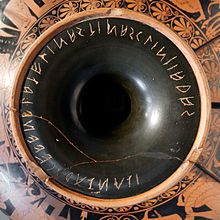 Etruscan inscription to the Dioscuri as "sons of Zeus" on the bottom of an Attic red-figure kylix (ca. 515–510 BC)
Etruscan inscription to the Dioscuri as "sons of Zeus" on the bottom of an Attic red-figure kylix (ca. 515–510 BC)
The Etruscans venerated the twins as Kastur and Pultuce, collectively the tinas cliniiaras, "sons of Tinia," the Etruscan counterpart of Zeus. They were often portrayed on Etruscan mirrors.[30] As was the fashion in Greece, they could also be portrayed symbolically; one example can be seen in the Tomba del Letto Funebre at Tarquinia where a lectisternium for them is painted. They are symbolised in the painting by the presence of two pointed caps crowned with laurel, referring to the Phrygian caps which they were often depicted as wearing.[31]
Celtic Dioscuri
The 1st-century BC historian Diodorus Siculus records counterparts of the Dioscuri among the Atlantic Celts:
The Celts who dwell along the ocean venerate gods who resemble our Dioscuri above any of the gods, since they have a tradition handed down from ancient times that these gods came among them from the ocean. Moreover, there are on the ocean shore, they say, many names which are derived from the Argonauts and the Dioscuri.[32]
Diodorus cites Timaeus (3rd century BC) as his source, so the passage is usually regarded as a description of an authentic Celtic tradition rather than an adoption from the Romans as a result of the conquest.[33] The divine twins among the Celts would be analogous in the Indo-European tradition to the Vedic Aśvins, or to the Germanic twins[34] mentioned by Tacitus.[35] Their Celtic names are unknown; the conjecture Divanno and Dinomogetimarus, based on an inscription from Hérault naming a pair of young warrior gods (Martes),[36] has not found wide support.[37] The 19th-century Celticist Marie Henri d'Arbois de Jubainville equated Cernunnos with Castor and Smertullos with Pollux, and conjectured that Cúchulainn and Conall Cernach were later equivalents: "on the whole, the theory is more ingenious than convincing."[38] The Pillar of the Boatmen depicts the twins among Celtic figures such as Cernunnos and Esus, as well as Roman deities such as Jupiter and Vulcan.[39] The Dioscuri are widely portrayed in Gallo-Roman art, and references to them are more numerous in Gaul than in any other part of the Roman Empire.[40]
Christianization
Even after the rise of Christianity, the Dioskouroi continued to be venerated. The fifth-century pope Gelasius I attested to the presence of a "cult of Castores" that the people did not want to abandon. In some instances, the twins appear to have simply been absorbed into a Christian framework; thus fourth-century AD pottery and carvings from North Africa depict the Dioskouroi alongside the Twelve Apostles, the Raising of Lazarus or with Saint Peter. The church took an ambivalent attitude, rejecting the immortality of the Dioskouroi but seeking to replace them with equivalent Christian pairs. Saints Peter and Paul were thus adopted in place of the Dioskouroi as patrons of travellers, and Saints Cosmas and Damian took over their function as healers. Some have also associated Saints Speusippus, Eleusippus, and Melapsippus with the Dioskouroi.[15]
In culture
Castor et Pollux was the title of a 1737 opera by Jean-Philippe Rameau (libretto by Bernard), modified in 1754. The latter version became quite popular. The Italian composer Francesco Bianchi wrote another version called Castore e Polluce, first performed in 1779, and there was yet another opera by the same title by Georg Joseph Vogler in 1787.
In 1842 Lord Macaulay wrote a series of poems about Ancient Rome (the Lays of Ancient Rome). The second poem is about the Battle of Lake Regillus and describes the intervention of Castor and Pollux. They are referred to as the "Great Twin Brethren" in the poem. [1]
Castor and Pollux (elephants) were killed and eaten during the 1870 Prussian siege of Paris.
There are at least four sets of twin summits named after Castor and Pollux. In Yellowstone National Park in Wyoming, USA, the peaks are found close to the headwaters of the Lamar River in the Absaroka Range. Another pair is located in the Pennine Alps at the Swiss-Italian border. A third is in Glacier National Park of western Canada, within the Selkirk mountains. The fourth is in Mount Aspiring National Park of New Zealand, named by the explorer Charlie Douglas.
Castor and Pollux are characters that appear in a few of Robert A. Heinlein's books.
Castor Troy and Pollux Troy are villains (brothers) that appear in the 1997 film Face/Off.
Also, in the Percy Jackson & the Olympians fantasy series of novels series, Dionysus' twin sons are named Castor and Pollux. In the fourth book of the series Castor is killed in the battle, thus following the story of one passing and the other living.
The character Sollux Captor's name of Andrew Hussie's Homestuck was based off of Castor and Pollux, mostly due to the fact that the two stars with the same name are in the constellation Gemini.
References
- ^ "Dioscuri." Bloomsbury Dictionary of Myth. London: Bloomsbury Publishing Ltd, 1996.
- ^ Scholiast on Lycophron, noted by Karl Kerenyi, 1959. The Heroes of the Greeks p.107 note 584.
- ^ The familiar theme in Greek mythology of the mixed seed of a mortal and an immortal father is played out in various ways: compare Theseus.
- ^ a b Burkert 1985:212.
- ^ "Dioscuri". A Dictionary of World Mythology. Arthur Cotterell. Oxford University Press, 1997.
- ^ "Dioscūri". The Concise Oxford Companion to Classical Literature. Ed. M.C. Howatson and Ian Chilvers. Oxford University Press, 1996.
- ^ a b c "Dioscūri". Oxford Dictionary of the Classical World. Ed. John Roberts. Oxford University Press, 2007.
- ^ a b c Robert Christopher Towneley Parker "Dioscuri." The Oxford Classical Dictionary. Ed. Simon Hornblower and Anthony Spawforth. Oxford University Press 2003.
- ^ David Campbell, "Greek Lyric Poetry" Bristol Classical Press 1967
- ^ Phoebe ("the pure") is a familiar epithet of the moon, Selene; her twin's name Hilaeira ("the serene") is also a lunar attribute, their names "appropriate selectively to the new and the full moon" (Kerenyi 1959:109).
- ^ a b c d e f g h i j k l Potis Stratikis, Greek Mythology, Vol. B, pp. 20-23 (1987).
- ^ a b c "Dioscuri." Encyclopædia Britannica. 2008.
- ^ "Castor and Polydeuces." Who's Who in Classical Mythology, Routledge. London: Routledge, 2002.
- ^ In the oration of the Athenian peace emissary sent to Sparta in 371, according to Xenophon (Hellenica VI), it was asserted that "these three heroes were the first strangers upon whom this gift was bestowed." (Karl Kerenyi, 1967. Eleusis: Archetypal Image of Mother and Daughter (Princeton: Bollingen), p. 122.
- ^ a b Alexander Kazhdan, Alice-Mary Talbot "Dioskouroi". The Oxford Dictionary of Byzantium. Ed. Alexander P. Kazhdan. Oxford University Press 1991.
- ^ Scholiast on Lycophron, noted by Karl Kerenyi, 1959. The Heroes of the Greeks, p. 107 note 584.
- ^ "Dioscuri". A Dictionary of the Bible. W. R. F. Browning. Oxford University Press, 1997.
- ^ Burkert 1985; Kerenyi 1959:107)
- ^ Nick Sekunda, Nicholas Victor Sekunda, Richard Hook, The Spartan Army, p. 53. Osprey Publishing, 1998. ISBN 1-85532-659-0
- ^ Sarah B. Pomeroy, Spartan Women, p. 114. Oxford University Press US, 2002. ISBN 0-19-513067-7
- ^ Guy Davenport, Objects on a Table: Harmonious Disarray in Art and Literature, p. 63. Basic Books, 1999. ISBN 1-58243-035-7
- ^ Kerenyi 1959 draws attention especially to the rock carvings in the town of Akrai, Sicily (1959:111).
- ^ Burkert 1985:212, who notes Chapouthier, Fernand , Les Dioscures au service d'une déesse, 1935.
- ^ Tacitus, Germania 43; Bernhard Maier, Dictionary of Celtic Religion and Culture (Boydell & Brewer, 1997), p. 96.
- ^ Mary Beard, John North, Simon Price, Religions of Rome: Volume 1, A History, p. 21. Cambridge University Press, 1998. ISBN 0-521-45646-0
- ^ Christopher Smith, "The Religion of Archaic Rome," in A Companion to Roman Religion (Blackwell, 2007), p. 37.
- ^ Theodor Mommsen, The History Of Rome, Book II, p. 191. Kessinger Publishing, 2004 (reprint). ISBN 1-4191-6625-5
- ^ "Dioscuri". A Dictionary of World Mythology. Arthur Cotterell. Oxford University Press, 1997.
- ^ Myles McDonnell, Myles Anthony McDonnell, Roman Manliness, p. 187. Cambridge University Press, 2006. ISBN 0-521-82788-4
- ^ Giuliano Bonfante, Larissa Bonfante, The Etruscan Language, p. 204. Manchester University Press, 2002. ISBN 0-7190-5540-7
- ^ Nancy Thomson De Grummond, Erika Simon, The Religion of the Etruscans, p. 60. University of Texas Press, 2006. ISBN 0-292-70687-1
- ^ Diodorus Siculus 4.56.4.
- ^ "Gallo-Roman Deities," in American, African, and Old European Mythologies (University of Chicago Press, 1993), p. 201; Philip Freeman, "Greek and Roman Accounts of the Ancient Celts," in Celtic Culture: A Historical Encyclopedia, edited by John Koch (ABC-Clio, 2006), p. 849.
- ^ Tacitus, Germania 43.
- ^ Bernhard Maier, Dictionary of Celtic Religion and Culture (Boydell & Brewer, 1997), p. 96.
- ^ CIL XII.4218, as noted by Bernhard Maier, Die Religion der Kelten: Götter, Mythen, Weltbild (C.H. Beck, 2004), p. 195; American, African, and Old European Mythologies, p. 201.
- ^ Maier, Dictionary of Celtic Religion and Culture, p. 96.
- ^ As noted by J.A. MacCulloch, The Religion of the Ancient Celts (Dover, 2003, originally published 1911), pp. 136–137. David Rankin, Celts and the Classical World (Routledge, 1996), p. 82, repeats the possible identification with Cernunnos and Smertullus.
- ^ "Dioscuri". A Dictionary of Celtic Mythology. James McKillop. Oxford University Press, 1998.
- ^ "Gallo-Roman Deities," in American, African, and Old European Mythologies, p. 201.
Sources
- Ringleben, Joachim, "An Interpretation of the 10th Nemean Ode", Ars Disputandi. Translated by Douglas Hedley and Russell Manning. Pindar's themes of the unequal brothers and faithfulness and salvation, with the Christian parallels in the dual nature of Christ.
- Burkert, Walter, 1985. Greek Religion (Cambridge: Harvard University Press), pp. 212–13.
- Kerenyi, Karl, 1959. The Heroes of the Greeks (Thames and Hundson), pp 105–112 et passim.
- Pindar, Tenth Nemean Ode.
- Theoi Project: Dioskouroi Excerpts in English of classical sources.
Roman mythology and religion Deities Apollo · Bona Dea · Castor and Pollux · Ceres · Cupid · Diana · Dis Pater · Faunus · Genius · Hercules · Janus · Juno · Jupiter · Lares · Liber · Mars · Mercury · Minerva · Orcus · Neptune · Penates · Pluto · Priapus · Proserpina · Quirinus · Saturn · Silvanus · Sol · Venus · Vesta · Vulcan
See also List of Roman deitiesAbstract deities Legendary founders Texts Vergil, Aeneid · Ovid, Metamorphoses and Fasti · Propertius, Elegies Book 4 · Apuleius, Metamorphoses (The Golden Ass)Concepts and practices See also Categories:- Greek mythology
- Argonauts
- Greek gods
- Twin people
- Offspring of Zeus
- Fictional twins
- Demigods of Classical mythology
- Laconian mythology
- Greek mythological hero cult
- Cybele
- Greek underworld
Wikimedia Foundation. 2010.


